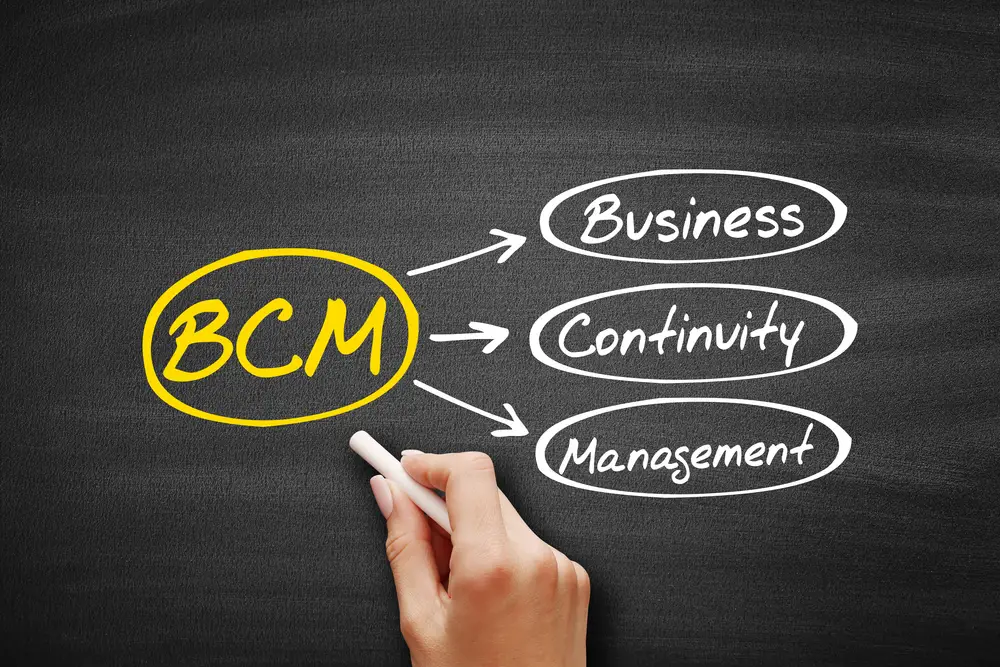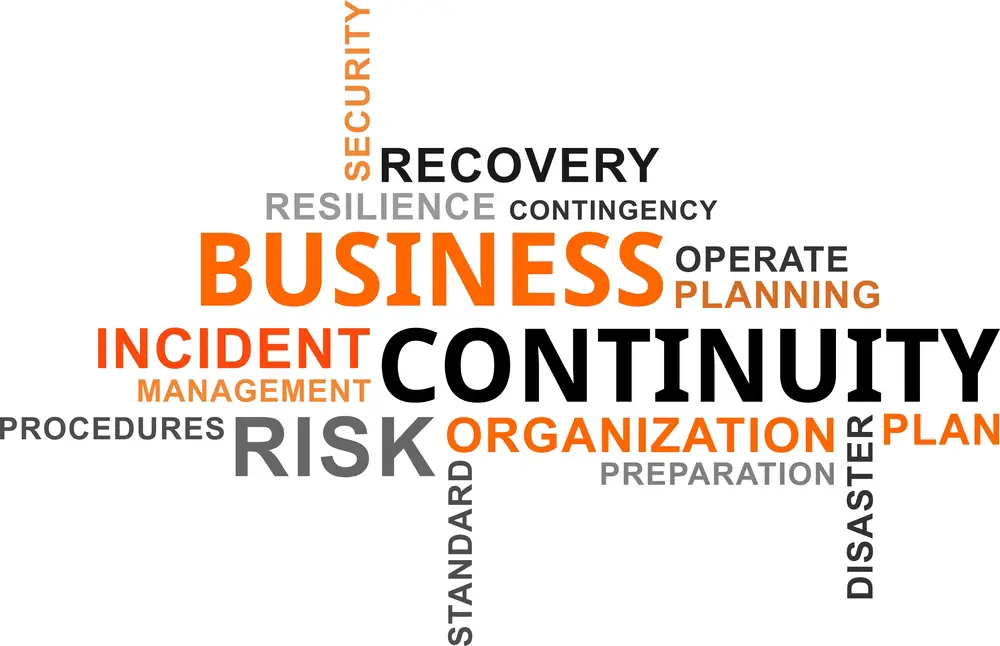A Business Continuity Management System is essential to planning for the unexpected. It provides organizations with strategies and tools to anticipate potential risks, protect data and assets, and keep operations running normally during a time of disruption.
The main key elements of a BCMS is a holistic framework designed to help companies recover quickly from disruptive events by documenting and executing procedures swiftly.
This should include documented sources of information, pre-defined recovery procedures, staff training, testing and simulation activities, and review schedules. Adopting a system like this enables companies to be better prepared should they experience an unforeseen event, such as an IT outage or natural disaster, enabling them to resume normal operation in the shortest possible time.
Business continuity management systems are important for companies to develop in order to ensure that operations can continue during an emergency. The following elements make up a business continuity management system:
Risk Assessment
Identify and analyze possible threats or risks and determine the potential impact they could have on operations if they were to occur.
Analyze what areas will be affected by the hazards or risks identified in the risk assessment, including potential financial losses, personnel, and other resources that may be impacted.
Recovery Strategies
Develop strategies for recovering from disruptions due to disasters or other emergencies, such as data recovery plans, alternative sourcing arrangements, backup power systems, and alternate facility locations.
Create detailed procedures for responding to different types of incidents based on the type of hazard and its impact on the organization’s operations. These should include contact information for key personnel in case of an emergency and protocols for communication with staff and customers.
Testing Plans
Develop plans to test all aspects of the business continuity management system regularly and consistently in order to identify weaknesses or gaps that need addressing before a disaster occurs.
Maintenance Plan
Maintain records of all recovery strategies, response plans, testing plans, etc., so they remain up-to-date with changes in the organization’s operations or environment that could affect them over time.
Planning, testing, and recovery of these critical components is essential for ensuring a robust organization
Business continuity management (BCM) is essential if an organization hopes to survive and thrive during unexpected events like pandemics, natural disasters, or cyberattacks. BCM should support a business’s objectives and ensure the long-term survival of its people, products, processes, and assets.
A robust Business Continuity Management System (BCMS) can be established by considering certain elements that allow for agility and resilience in the face of various threats. Read on to learn about these elements and how they can help protect your business from catastrophic losses caused by difficult circumstances.

Key Components of a Business Continuity Plan (BCP)
A business continuity plan (BCP) can be an invaluable resource in preparing your business for unexpected potential disasters. It ensures that processes remain uninterrupted if any disruption occurs and is essential to preparing a long-term sustainable plan in the event of major losses.
One of the key components of a BCP involves acquiring and maintaining reliable backup systems and data, as well as creating protocols that can be used to protect both employees and customers.
Another important part is conducting regular drills and training employees to use the resources provided by the BCP in case something does happen, ensuring everyone knows how to respond should the situation arise.
A well-planned organization’s business continuity plan will help businesses quickly prepare for incidents and recover from them, minimizing losses.
Why is business continuity important?
1) Business continuity planning ensures that your company can continue to operate in the event of a disaster or emergency. This could be anything from a natural disaster, such as a tornado or hurricane, to a man-made disaster, such as a terrorist attack.
2) A well-developed business continuity plan can help you minimize the impact of a disaster on your business.
3) Business continuity planning helps you ensure that your critical systems and data are protected during an outage or interruption.
4) Having a business continuity plan in place can minimize downtime and protect your reputation and brand.
In times of inconvenient downtime, businesses need reassurance. Downtimes come in many different forms. Other threats have been reported, such as cyber-attacks and extreme weather. Business continuity plans should consider potential disturbances to operations.
The organization is recommended to keep running for a short period during emergencies. Business continuity helps to keep organizations resilient and respond quickly when interrupted. Business continuity is essential for the survival of businesses. A prolonged interruption can cause financial loss, personal loss, and reputation damage to the company’s business.

Disaster Recovery and Business Continuity Planning
A business continuity plan can also be defined in a consolidated business continuity framework as a document that describes steps for responding, recovering, or recovering to a specified level of operation.
Restored data can be a subset within the whole BCP as it depends on data that isn’t stored on a computer. Organizations create a suite of recovery points and recovery time objectives (RTO), enabling customers to minimize their loss of business.
Disaster recovery planning is key to protecting businesses and their continuity. This involves securing data, developing a continuity plan, and testing the system in case of an unforeseen disaster or emergency. Disaster recovery planning allows businesses to respond fast to any disruption that could threaten their operations.
A comprehensive disaster recovery plan should include practices for risk management, backups, hardware specifications, system validations, reviews of software and updates, and off-site storage for system replicas if needed.
When well planned, representatives from various departments within the business can help ensure that all critical functions are adequately addressed and are resilient enough to survive a disaster. Adopting a proactive approach toward disaster management helps organizations stay agile enough to get back on their feet as soon as possible after a crisis situation occurs.
The Business Continuity Plan (BCP)
Business Continuity Planning (BCP) is an essential process for any organization, large or small. A BCP aims to set out a road map to help maintain business operations and protect against interruptions caused by natural disasters, cyberattacks, or any other unexpected event.
BCPs ensure that your business is adequately protected by providing strategies designed to help the organization recover quickly and sustain operations over the long term. This can include measures such as regularly backing up important data and having crisis management plans in place should any emergency arise.
The plan covers all aspects of disaster response and recovery for the company. This is essentially based on Business continuity management (BCM). Throughout the document, the steps needed are listed as preventative measures to mitigate the risks of an emergency situation.
If BCPs can answer these questions, they should not create confusion. Executive managers, stakeholders, and employees know the best ways to do things.
Business Continuity Planning
A Comprehensive business continuity plan is a set of measures designed to ensure the continuity of a company’s vital operations during a catastrophe or emergency situation. The plan outlines short and long-term disruptions and may also contain provisions to handle both manmade disasters and natural disasters.
The essential operation can be defined as requiring the preservation of life and the maintenance of critical infrastructure. They also include crucial business functions i.e. financial services and products.
Recovery Teams
Your continuity plan doesn’t work without coordinating the team. They are typically known as the recovery team and are responsible for planning and conducting your emergency procedure. Your recovery team carries many responsibilities.
The team should include IT personnel from different business-critical sectors. These contacts don’t always require departmental managers.
Risk Assessment
Risk assessment refers to assessing risks to the operation of organizations and the associated activities. Here are a couple of examples of hazards identified – Probabilities – Magnitude. Assets at risk – Vulnerability analysis.
Business Impact Analysis (BIA)
A Business Impact Analysis helps determine the impacts of business disruptions on your operations and helps to gather information for preparing recovery plans.
Business continuity vs. disaster recovery
Business continuity and disaster recovery are closely related concepts, but the two have some key differences.
Business continuity focuses on preventing disruptions from occurring in the first place. This means having effective processes, systems, and procedures in place to identify potential threats and mitigate their impact before they can cause harm.
Disaster recovery kicks in when a disruption has already occurred. The goal is to restore operations and quickly minimize losses resulting from disruption. This typically involves developing an actionable plan for responding to a disaster, as well as regularly testing these plans to ensure they will be most effective when needed.
Identify Critical Functions
Identifying critical functions can identify processes essential to the operation of an organization when an unplanned failure occurs. You need to pinpoint your strategic business priorities first. It may not be.
Business Continuity Management Process
Business continuity planning (BCP) is an integrated business plan based on an operational plan that consists of several activities and steps that are carried out to maintain critical business processes.
The business continuity planning process involves identifying potential threats, assessing their impact, developing strategies for mitigating risk, and creating an action plan for recovery. To ensure maximum preparedness, it is important to establish roles and responsibilities within the organization, conduct regular testing of the plans, and update plans as needed.
The BCM processes begin with risk assessment and identification of important business functions and proceed to develop and implement continuity planning for such functions. The BCM program needs regular testing and updates to reflect changes in the industry environment.
Likewise, CM should include regular communication with employees and training to ensure all employees know the importance of maintaining continuous operations.

What’s the difference between BCM and BCP?
Business continuity plans are a key component of business continuity management (BCM). BCM refers to the general management of continuity strategy implementations, and BCP refers to documents.
Business Continuity Management (BCM) and Business Continuity Planning (BCP) are two closely related concepts. BCM is the overall management of an organization’s continuity strategy, while BCP focuses on developing a plan to resume operations during an unplanned disruption.
BCM includes the development of a plan but also involves processes such as risk assessment, business impact analysis, and testing. It also includes roles and asset management. BCP is an integral part of BCM that outlines the steps needed to restore operations after a disruption.
ERM (Enterprise Risk Management) and BCM also work together to create a comprehensive approach to risk management. ERM helps identify potential risks before they occur, while BCM focuses on creating plans for how to respond when those risks become a reality.
Overall, Business Continuity Management is a comprehensive approach to managing continuity strategies that include Business Continuity Planning and other processes such as risk assessment and business impact analysis.
Conclusion
The importance of having a well-designed business continuity management system cannot be overstated. This system should include elements that ensure organizational obligations and goals will be met while also protecting the organization from financial or legal liabilities.
The best business continuity systems should include an emergency response plan, a risk assessment program, a process for researching and selecting vendors, and emergency protocols that are often revisited and updated as needed.
Having all of these components in place will guarantee your success under various circumstances and give customers, clients, and stakeholders peace of mind when shopping with you or investing in your company.
In today’s ever-changing business world, a well-crafted business continuity management system is more important than ever and recognizing the need to have one means you’re on your way to setting yourself up for long-term success.
Have you read?
What is a business continuity management system?
Objectives of business continuity management system
why business continuity management system
What are key elements of business continuity management
Key components of business continuity management system
What are the 3 elements of business continuity ?

Chris Ekai is a Risk Management expert with over 10 years of experience in the field. He has a Master’s(MSc) degree in Risk Management from University of Portsmouth and is a CPA and Finance professional. He currently works as a Content Manager at Risk Publishing, writing about Enterprise Risk Management, Business Continuity Management and Project Management.

